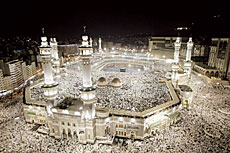· Description
The Dar-ul-Islam Movement grew out of the Brooklyn-based State Street Mosque. The State Street Mosque was established in 1939 by Grenadian Shaykh Daoud Faisal. Founders of the Dar-ul-Islam Movement, The DAR, regularly attended the State Street Mosque before leaving to establish the DAR in 1962. Rijab Mahmoud was the first elected Imam of the new Dar community. He served until 1968 when Yahya Abdul Karim was elected Imam of the growing DAR community. Headquartered in Yasin Mosque on Herkimer Place in Brooklyn, the DAR thrived as a national organization with chapters in the Caribbean. The membership of the DAR was based on bai’ah, pledge of allegiance to the national Amir through bai’ah to local Amirs. The organization was based on the leadership’s understanding and literal interpretation of the Qur’an and Sunnah. The organization’s men wore mostly traditional or modified versions of Arab garb and followed a literal interpretation of the Sunnah. Imam Yayha served from 1968 until 1979 when the movement was taken over by Pakistani mystic Sheikh Mubarak Ali Jilani. Founded in 1980 as Al-Fuqara and later named Muslims of America, Sheikh Jilani’s movement effectively dismantled the Movement splitting the DAR’s membership between loyalist to Sheikh Jilani and those committed to the original mission of the DAR. Of those refusing to follow Jilani, Imam Al-Amin Abdul Latif, long-time DAR member in New York, headed the northern wing of Al Ummah, the new name for the former Dar-ul-Islam Movement. Imam Jamil Al-Amin, founder of the Community Masjid in Atlanta and member of the DAR Movement since his shahadah in 1971, was named the Southern leader of Al Ummah.
· Contributions/Successes
The Brooklyn-based Dar-ul-Islam Movement, in conjunction with its renamed successor, Al- Ummah, is the first African American Sunni organization to organize and sustain chapters across the United States for over five decades. Members of the organization practiced a strict interpretation of Sunnah which they believed to be appropriate in the American context. DAR members were a visible alternative for Black community residents to the bow-tie wearing men of the Nation of Islam. For decades, immigrants Muslims were not easily identifiable as Muslims in the streets and neighborhoods of this country. The organization encouraged entrepreneurship among its members resulting in the establishment of many businesses throughout the country. Individual members also started cottage industries like making, packaging, and selling incenses and oils on the streets and in other public venues. The Dar-ul-Islam was the first Sunni Muslim organization to establish and maintain a decades-long Prison Program, especially in New York. Hundreds, if not thousands, of Shahadahs were administered in the nation’s jails and prisons at the hands of DAR volunteers.
· Failures
To a certain degree, the DAR failed to fully incorporate the Muslim intelligentsia into its leadership structure and membership. The group was characterized by many as having an anti-intellectual approach to incorporating new ideas and approaches. The DAR created a generational issue through its wide practice of polygyny. Too many brothers took multiple wives and had many children without having the capacity to take care of their financial, material, or emotional needs.
· Lessons
Avoid the trap of listening only to our own voices and show a willingness to look outside of one's own organizational, ideological, and biological forefathers for ideas and examples.
